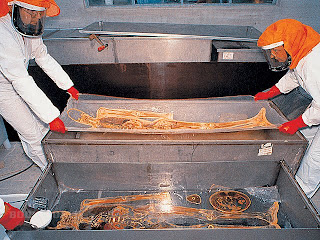“I developed the Plastination technique at the University of Heidelberg’s Institute of Anatomy in 1977, patented it between 1977 and 1982, and have been continually improving the process ever since.
When, as an anatomy assistant, I saw my first specimen embedded in a polymer block, I wondered why the polymer had been poured around the outside of the specimen as having the polymer within the specimen would stabilize it from the inside out. I could not get this question out of my mind. A few weeks later, I was to prepare a series of slices of human kidneys for a research project. The usual process of embedding the kidneys in paraffin and then cutting them into thin slices seemed like too much wasted effort to me, as I only needed every fiftieth slice. Then one day, I was in the butcher shop in the university town where I was studying, and as I watched the sales woman slice ham, it dawned on me that I ought to be using a meat slicer for cutting kidneys. And so a "rotary blade cutter," as I called it in the project-appropriation request, became my first Plastination investment. I embedded the kidney slices in liquid Plexiglas and used a vacuum to extract the air bubbles that had formed when stirring in the curing agent. As I watched these bubbles, it hit me: It should be possible to infuse a kidney slice with plastic by saturating it with acetone and placing it under a vacuum; the vacuum would then extract the acetone in the form of bubbles, just as it had extracted air before. When I actually tried this, plenty of acetone bubbles emerged, but after an hour the kidney was pitch black and had shrunk. At this point most people would have dismissed the experiment as a failure, and the only reason I went ahead and repeated it a week later using silicone rubber was because my basic knowledge of physical chemistry told me that the blackening effect was due to the index of refraction of the Plexiglas, and that the shrinkage could be attributed to having permeated the specimen too quickly. The next time, I carried out this process more slowly, using three successive silicone baths as a means of preventing a single bath (along with its contents) from curing too quickly. After curing the specimen in a laboratory kiln, I had the first presentable sample of Plastination.
That was on January 10, 1977, the day that I decided to make Plastination the focus of my life."
Gunther von Hagens
Inventor of Plastination







